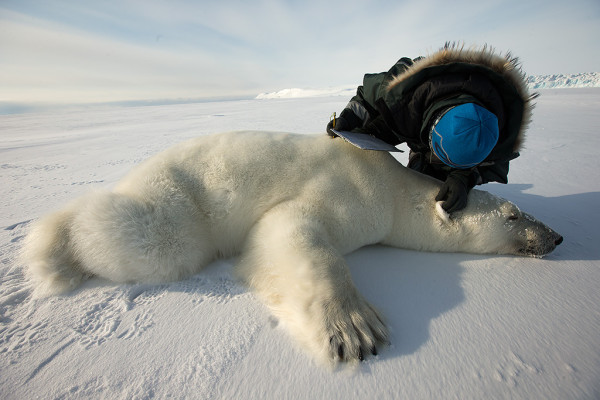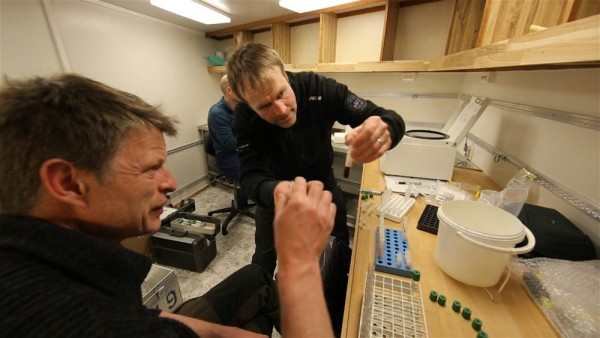From April 11 to 21, 2014, join a Norwegian Polar Institute and WWF-Canon scientific expedition to collect critical data about Europe’s most westerly polar bear population. The population on and around the Norwegian Arctic archipelago of Svalbard is facing a future without summer sea ice. See all posts from the expedition here.

Not all aspects of polar bear research are high-tech. Here, the researchers weigh a bear. © Brutus Ostling / WWF-Canon
The capture mission last night was successful- one recaptured female who was fitted with a fresh satellite collar and one large male. The crew from NPI is very efficient with their sample processing and equipment cleaning routine: spinning whole blood samples, separating serum and packed red cells, while cleaning and repacking equipment for the next day. It is a real treat and great learning opportunity to watch colleagues in the field, comparing methods and brainstorming new ideas. I’m certain that the makers and sellers of fishing tackle boxes never imagined how wildlife biologists around the world would use their products one day!
Overnight, the ship moved further north around the northern tip of Spitsbergen before turning southeast down Hinlopenstretet to the Island and strict nature reserve of Nordaustlandet- the true kingdom of the polar bear and walrus. Once again, as if scheduled, we are all awakened by the sudden rumble and swish of the ship breaking ice as she finds a spot to park in Wahlenbergfjorden at 5 AM. This is much thicker ice than before and we look out to a completely fast frozen seascape of ice that is 2-3 feet thick and dotted with glacial bergs much thicker and looking like deep blue jewels strewn across the fjord. The land here is much lower and fairly flat on top, though it still rises sharply from the shore.
After the capture crew sets off, those of us on the boat prepare to go for a short walk on the sea ice near the ship as the crew works to anchor us in for a couple of days. For two of our team, it is their first trip to the Arctic and their first time walking on frozen ocean. As luck would have it, within 50 meters of the ship we encounter fresh polar bear tracks! As the assigned bear guard, I scout the vicinity to make sure the track maker is not still close by before waving the team over for a closer look. Standing on a small blue ice berg in the otherwise frozen fjord, we have a commanding view of the fjord, some glaciers, and the surrounding landscape. Absolutely beautiful, even when draped all in white snow and ice.

